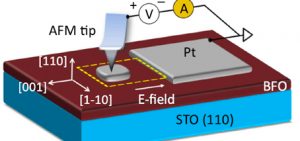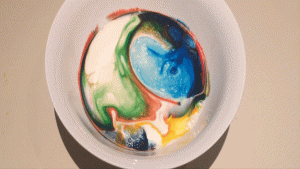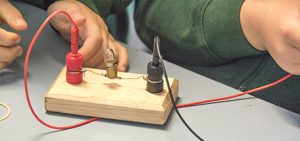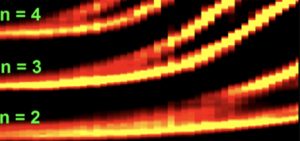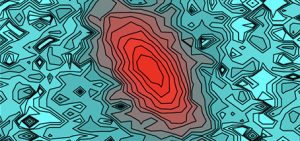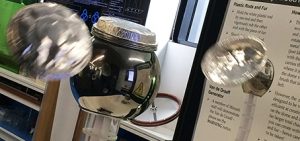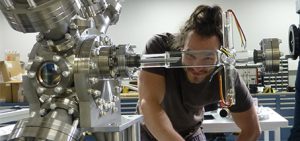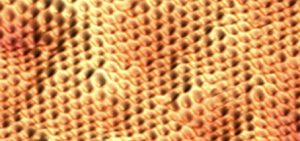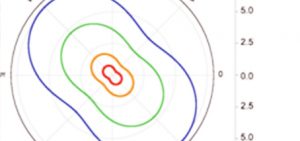Engage
See news from around FLEET, below
Catch up on all past issues of FLEET News newsletter
FLEET News
A UNSW study published last Friday presents an exciting step towards a novel form of electronics based on nano-scale, ‘disappearing’ conduction paths that could allow for extremely dense memory storage. It’s based on domain walls, which are atomically sharp topological defects separating regions of uniform polarisation in ferroelectric materials. The domain walls are electrically conductive, while the surrounding of the wall …
FLEET aims to make science more accessible to the wider community, and to bring science to kids who will become Australia’s future great scientists and engineers. So today, we’re launching a new program of home science activities for kids. FLEET will provide ideas for fun science activities and experiments that are easy to do in the home. Our first three …
A recent Monash University study has investigated Fermi gases with only a small number of interacting particles, and has used that simplified case to predict some behaviours within Fermi gases with many more particles. The study was published in Journal of Physics B: Atomic, Molecular and Optical Physics, March 2017 FLEET’s Meera Parish is investigating how robust excitonic superfluidity is …
FLEET’s Senior Education & Training Coordinator visited a primary school to speak to Grade 2 students about electricity and electrons. Students were challenged to make a light bulb light up using a battery and some wires, and to find materials that could act as conductors. The students have been studying about materials and technology this term, so the topics fit …
FLEET is seeking 16 talented postdoctoral scientists with backgrounds in Physics, Materials Science, Chemistry, Nanotechnology, Electronic Engineering and other equivalent fields. Research fellowships are available for talented postdoctoral scientists, offered at six FLEET nodes: Monash University, the University of New South Wales, RMIT University, Swinburne University of Technology, the Australian National University and the University of Wollongong. Work with us …
Spin-orbit interaction (SOI), is the interplay between electrons’ inherent angular momentum (their quantum spin) and their orbit around an atom’s nucleus. This interaction is key to the function of topological materials, which are studied at FLEET for their potential to form ultra-low resistance pathways for electrical current. A recent study investigated the relationship between spin-orbit interactions in gallium arsenide quantum …
A barrier to practical spintronic devices has been lowered as room-temperature ferromagnetic semiconductors created in an international collaboration involving FLEET’s Xiaolin Wang. While semiconductor spintronics promise lower switching energy and faster speed, a major limitation on its development as a viable technology is the lack of room temperature ferromagnetic semiconductor materials. A collaborative study between researchers from two Chinese universities …
The National Science Quiz will be held in Melbourne on Sunday 18 June at 3pm. FLEET Director, Professor Michael Fuhrer, will be one of the scientists on the panel for this event. With live demonstrations and curiosity-provoking questions, the National Science Quiz is ninety minutes of science, maths, and laughs that promises fun for the whole family. #NatSciQuiz2017 Secure your …
FLEET staff will be visiting a primary school next week to talk to Grade 2 students about energy, electricity and technology. With the use of a van de Graaff generator, it’ll be a hair-raising experience! FLEET has a commitment to bringing science and research to the wider community. FLEET staff are currently developing a range of resources that can be …
A next-generation Bose-Einstein condensate apparatus being built at Monash University will allow bigger Bose-Einstein condensates to be created, and allow even higher resolution imaging of them. Researchers will also have better optical access to be able to manipulate the atoms within the condensate more precisely. The equipment will allow researchers to study non-equilibrium dynamics and quantum turbulence. FLEET Chief Investigator …
The future of ultra-low resistance semiconductor junctions in novel low-energy electronics is looking good after a recent study took a very close look at band alignment. FLEET is using two-dimensional materials in the search for new electronics devices that will carry electrical current without losing the significant energy dissipated in current, silicon technology. The new electronic devices developed at FLEET …
A study by FLEET’s UNSW researchers looked at spin-orbit interaction at the two-dimensional interface between common semiconductor materials. A new semi-analytical method was developed for analysis. Spin-orbit interaction (SOI), is the interplay between electrons’ inherent angular momentum (their quantum spin) and their orbit around an atom’s nucleus. This interaction is key to the function of topological materials, which are studied …

